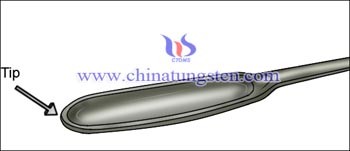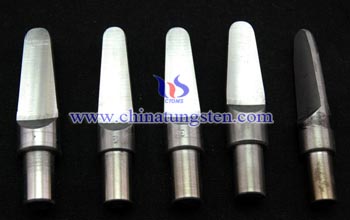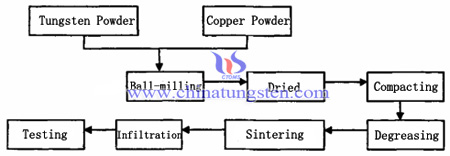Comparing Thermal and Mechanochemical Decomposition of Ammonium Paratungstate (APT)
- Details
- Category: Tungsten Information
- Published on Thursday, 26 November 2015 15:27
Ammonium paratungstate (or APT) is a white crystalline salt of ammonium and tungsten, with the chemical formula (NH4)10(H2W12O42)·4H2O.
Ammonium paratungstate is produced by separating tungsten from its ore. Once the ammonium paratungstate is prepared, it is heated to its decomposition temperature, 600 °C. Left over is WO3, tungsten(VI) oxide. From there, the oxide is heated in an atmosphere of hydrogen, reducing the tungsten to elemental powder, leaving behind water vapor. From there, the tungsten powder can be fused into any number of things, from wire to bars to other shapes.
In this research, the possibility of mechanochemical decomposition of ammonium paratungstate (APT) has been studied, and compared with thermal decomposition method. For this purpose, APT powders were milled using a planetary ball mill up to 36 hours and under air atmosphere. For thermal decomposition, APT powders were heated for 30 minutes at 300 and 450°C in air atmosphere. X-ray diffraction (XRD), differential scanning calorimeter (DSC), and thermo gravimetric analyzer (TGA) were used to study the decomposition progress, and products. The XRD results showed that APT completely decomposed to WO3 by thermal decomposition, while the final product of mechanochemical decomposition was WO3 (H2O)0.5. According to DSC and TGA results, during thermal decomposition, ammonia and water released in four steps, and leaved WO3. By mechanochemical decomposition crystal water and ammonia liberated from APT structure, but structural water of APT remained. In both methods, an X-ray amorphous phase was the intermediate product of APT decomposition.
| Tungsten Supplier: Chinatungsten Online www.chinatungsten.com | Tel.: 86 592 5129696; Fax: 86 592 5129797;Email:sales@chinatungsten.com |
| Tungsten News & Prices, 3G Version: http://3g.chinatungsten.com | Molybdenum News & Molybdenum Price: http://news.molybdenum.com.cn |
Ti-W-Si-Al Based Coated Tungsten Carbide End Mills In Cutting Hardened Steel Ⅳ
- Details
- Category: Tungsten Information
- Published on Thursday, 26 November 2015 15:18
In last part we know that tungsten carbide tools with (Ti,W)N coating film have superior critical scratch load to high speed cutting hardened steel in mass production. Here in this part we explain the superior quality of (Ti,W,Si)N coating film.
Moreover, the titanium/tungsten-based-coated tungsten carbide tool was evaluated through machining of low-carbon steel AISI 5120H, and showed greatly improved performance. However, the hardness of the (Ti,W)N coating film was lower than that of the (Ti,Al)N coating film. So, a (Ti,W,Si)N coating film, which is a titanium/tungsten/silicon-based coating film, has been developed.
This titanium/tungsten/silicon-based coating film exhibits both superior critical scratch load and hardness compared with TiN/(Ti,Al)N coating film. In cutting AISI 5120H, the wear progress of the (Ti,W,Si)N-coated cemented tungsten carbide tool is slower than that of the TiN- and (Ti, Al)N-coated tools. Therefore, titanium/tungsten/silicon coating is an effective tool material because it has good wear resistance.
(To be continued. This article is divided into several parts. Here is part 4. For part 3 please refer to http://news.chinatungsten.com/en/tungsten-information/80791-ti-10485; for part 5, please refer to )
| Tungsten Carbide Supplier: Chinatungsten Online tungsten-carbide.com.cn | Tel.: 86 592 5129696; Fax: 86 592 5129797;Email:sales@chinatungsten.com |
| Tungsten News&Tungsten Prices, 3G Version: http://3g.chinatungsten.com | Molybdenum News & Molybdenum Price: http://news.molybdenum.com.cn |
Ti-W-Si-Al Based Coated Tungsten Carbide End Mills In Cutting Hardened Steel Ⅲ
- Details
- Category: Tungsten Information
- Published on Thursday, 26 November 2015 15:15
In last part we know that tungsten carbide end mills with (Ti,W,Si,Al)N coating film have the least tool wear at speed of below 3.33 m/s in cutting hardened steel. Here in this part we explain the superior quality of (Ti,W)N coating film.
1. Introduction
Hardened steels used for dies or molds are widely cut as a substitute for grinding. Polycrystalline cubic boron nitride (cBN) compact tools are used for cutting hardened steels, due to their higher hardness and higher thermal conductivity. However, in milling, major tool failure of cBN readily occurs by fracture because cBN has poor fracture toughness. Coated cemented tungsten carbide is an effective tool material for milling hardened steels because it has good fracture toughness and wear resistance. The physical vapor deposition (PVD) method is a widely used coating technology because of its lower treatment temperature, namely 470 K -870 K.
Recently, it has become possible to cut hardened steels with (Ti,Al)N-coated tungsten carbide cutting tools. However, as machine parts are often cut at higher cutting speeds for mass production, tool materials must have excellent fracture toughness and wear resistance. A titanium/tungsten-based coating film, namely (Ti,W)N coating film, has been developed. Titanium/tungsten-based coating film exhibits a superior critical scratch load.
(To be continued. This article is divided into several parts. Here is part 3. For part 2 please refer to http://news.chinatungsten.com/en/tungsten-information/80790-ti-10484; for part 4, please refer to http://news.chinatungsten.com/en/tungsten-information/80792-ti-10486)
| Tungsten Carbide Supplier: Chinatungsten Online tungsten-carbide.com.cn | Tel.: 86 592 5129696; Fax: 86 592 5129797;Email:sales@chinatungsten.com |
| Tungsten News&Tungsten Prices, 3G Version: http://3g.chinatungsten.com | Molybdenum News & Molybdenum Price: http://news.molybdenum.com.cn |
Ti-W-Si-Al Based Coated Tungsten Carbide End Mills In Cutting Hardened SteelⅡ
- Details
- Category: Tungsten Information
- Published on Thursday, 26 November 2015 15:14
In last part we know that tungsten carbide end mills with (Ti,W,Si)N and (Ti,W,Si,Al)N coating films will be tested to determine the best materials for cutting hardened steel. Here in this part we give the results to be reached in this article.
The following results were obtained:
(1) In milling hardened steel at a cutting speed of 3.33 m/s, the tool wear width of the (Ti,W)N/(Ti,W,Si,Al)N-coated tungsten carbide end mill was smaller than that of the (Ti,W)N/(Ti,W,Si)N-coated one. And, compared with the commercial (Ti,Al)N, the tool wear width of the (Ti,W)N/(Ti,W,Si,Al)N-coated tool was smaller than that of the (Ti,Al)N-coated tool.
(2) The tool wear of the (Ti,W)N/(Ti,W,Si,Al)N-coated tool increased with an increase in cutting speed.
(3) The cemented carbide with (Ti,W)N/(Ti,W,Si,Al)N coating film was an effective tool material for high-speed cutting below a cutting speed of 3.33 m/s.
(To be continued. This article is divided into several parts. Here is part 2. For part 1 please refer to http://news.chinatungsten.com/en/tungsten-information/80788-ti-10483; for part 3, please refer to http://news.chinatungsten.com/en/tungsten-information/80791-ti-10485)
| Tungsten Carbide Supplier: Chinatungsten Online tungsten-carbide.com.cn | Tel.: 86 592 5129696; Fax: 86 592 5129797;Email:sales@chinatungsten.com |
| Tungsten News&Tungsten Prices, 3G Version: http://3g.chinatungsten.com | Molybdenum News & Molybdenum Price: http://news.molybdenum.com.cn |
Process for Producing Ammonium Paratungstate
- Details
- Category: Tungsten Information
- Published on Thursday, 26 November 2015 15:13
Ammonium paratungstate (or APT) is a white crystalline salt of ammonium and tungsten, with the chemical formula (NH4)10(H2W12O42)·4H2O.
Ammonium paratungstate is produced by separating tungsten from its ore. Once the ammonium paratungstate is prepared, it is heated to its decomposition temperature, 600 °C. Left over is WO3, tungsten(VI) oxide. From there, the oxide is heated in an atmosphere of hydrogen, reducing the tungsten to elemental powder, leaving behind water vapor. From there, the tungsten powder can be fused into any number of things, from wire to bars to other shapes.
A process is disclosed for producing ammonium paratungstate which involves adding hexamethylenetetramine to a first solution of ammonium tungstate, adjusting the pH to about 2 with an acid to form a precipitate which contains the major portion of the tungsten and the hexamethylenetetramine and separating the precipitate from the resulting mother liquor. The tungsten hexamethylenetetramine precipitate is then dissolved in aqueous ammonia to form a second ammonium tungstate solution which is then heated at from about 90℃ to about 100℃ to form a precipitate essentially all of which is ammonium paratungstate and a mother liquor which contains essentially all of the hexamethylenetetramine. The ammonium paratungstate precipitate is then separated from the mother liquor.
| Tungsten Supplier: Chinatungsten Online www.chinatungsten.com | Tel.: 86 592 5129696; Fax: 86 592 5129797;Email:sales@chinatungsten.com |
| Tungsten News & Prices, 3G Version: http://3g.chinatungsten.com | Molybdenum News & Molybdenum Price: http://news.molybdenum.com.cn |
Ti-W-Si-Al Based Coated Tungsten Carbide End Mills In Cutting Hardened SteelⅠ
- Details
- Category: Tungsten Information
- Published on Thursday, 26 November 2015 15:12
Abstract
In turning hardened steel, polycrystalline cubic boron nitride (cBN) compacts are widely used, due to their higher hardness and higher thermal conductivity. However, in milling hardened steel, fracture of cBN cutting tools readily occurs because they have poor fracture toughness. Therefore, coated cemented tungsten carbide tools, which have good fracture toughness and wear resistance, are generally widely used.
In this study, hardened steel (ASTM D2, JIS SKD11, 60HRC) was milled with three physical vapor deposition (PVD)-coated cemented tungsten carbide end mill cutters in order to determine effective tool materials for cutting hardened steel at high cutting speeds.
The coating films used were (Ti,W)N/(Ti,W,Si)N and (Ti,W)N/(Ti,W,Si,Al)N coating films. (Ti,W,Si,Al)N is a new type of coating film. The inner layer of the (Ti,W)N/(Ti,W,Si)N and (Ti,W)N/(Ti,W,Si,Al)N coating system is (Ti,W)N coating film, and the outer layer is (Ti,W,Si)N and (Ti,W,Si,Al)N coating films, respectively. Furthermore, commercial (Ti,Al)N-based coating film was also used.
(To be continued. This article is divided into several parts. Here is part 1. For part 2 please refer to http://news.chinatungsten.com/en/tungsten-information/80790-ti-10484)
| Tungsten Carbide Supplier: Chinatungsten Online tungsten-carbide.com.cn | Tel.: 86 592 5129696; Fax: 86 592 5129797;Email:sales@chinatungsten.com |
| Tungsten News&Tungsten Prices, 3G Version: http://3g.chinatungsten.com | Molybdenum News & Molybdenum Price: http://news.molybdenum.com.cn |
Tungsten Carbide Spoon BitsⅡ
- Details
- Category: Tungsten Information
- Published on Thursday, 26 November 2015 15:10
In last part we know that tungsten carbide spoon bits are used to boring holes in chairmaking with a spoon like point and grooved shank. This part we talk about how it works.
When reaming a pre-bored straight-sided hole, the tungsten carbide spoon bit is inserted into the hole and rotated in a clockwise direction with a carpenters' brace until the desired taper is achieved. When boring into solid wood, the bit should be started in the vertical position; after a "dish" has been created and the bit has begun to "bite" into the wood, the angle of boring can be changed by tilting the brace a bit out of the vertical. Holes can be drilled precisely, cleanly and quickly in any wood, at any angle of incidence, with total control of direction and the ability to change that direction at will.
Parallel tungsten carbide spoon bits are used primarily for boring holes in the seat of a Windsor Chair to take the back spindles, or similar round-tenon work when assembling furniture frames in green woodworking work.
The spoon bit may be honed by using a slipstone on the inside of the cutting edge; the outside edge should never be touched.

(The end-This article is divided into 2 parts. Here is part 2. For part 1 please refer to http://news.chinatungsten.com/en/tungsten-information/80786-ti-10481)
| Tungsten Carbide Supplier: Chinatungsten Online tungsten-carbide.com.cn | Tel.: 86 592 5129696; Fax: 86 592 5129797;Email:sales@chinatungsten.com |
| Tungsten News&Tungsten Prices, 3G Version: http://3g.chinatungsten.com | Molybdenum News & Molybdenum Price: http://news.molybdenum.com.cn |
Tungsten Carbide Spoon BitsⅠ
- Details
- Category: Tungsten Information
- Published on Thursday, 26 November 2015 15:08
Tungsten carbide spoon bits consist of a grooved shank with a point shaped somewhat like the bowl of a spoon, with the cutting edge on the end. The more common type is like a gouge bit that ends in a slight point. This is helpful for starting the hole, as it has a center that will not wander or walk. These bits are used by chair-makers for boring or reaming holes in the seats and arms of chairs. Their design is ancient, going back to Roman times. Spoon bits have even been found in Viking excavations. Modern spoon bits are made of tungsten carbide or carbon steel, carefully heat-treated and then hand ground to a fine edge.
Spoon bits are the traditional boring tools used with a brace. They should never be used with a power drill of any kind. Their key advantage over regular brace bits and power drill bits is that the angle of the hole can be adjusted. This is very important in chairmaking, because all the angles are usually eyeballed. Another advantage is that they do not have a lead screw, so they can be drilled successfully in a chair leg pretty much without having the lead screw peek out the other side.

(To be continued. This article is divided into 2 parts. Here is part 1. For part 2 please refer to http://news.chinatungsten.com/en/tungsten-information/80787-ti-10482)
| Tungsten Carbide Supplier: Chinatungsten Online tungsten-carbide.com.cn | Tel.: 86 592 5129696; Fax: 86 592 5129797;Email:sales@chinatungsten.com |
| Tungsten News&Tungsten Prices, 3G Version: http://3g.chinatungsten.com | Molybdenum News & Molybdenum Price: http://news.molybdenum.com.cn |
Tungsten Copper Electrode Infiltration Mechanism
- Details
- Category: Tungsten Information
- Published on Wednesday, 25 November 2015 17:07
In the process of tungsten copper, silver-tungsten, ferro tungsten mechanical parts and metal-ceramic materials, the infiltration method is one of the most major processes. Take tungsten copper electrodes for example, the infiltration process is immerse tungsten skeleton in liquid copper after high temperature sintered, so that the pores are filled with liquid copper, then by annealing and cooling to obtain a dense tungsten copper materials.
Thus, infiltration process is the preparation of tungsten-copper electrode in the most critical a process, which directly affects the overall performance of tungsten copper electrodes. However, the most of present study concentrated on the parameters of infiltration, for infiltration mechanism is quite few, and most of these studies are directed to coarse particles of tungsten powder, and rarely comes to fine particles of tungsten powder. Infiltration is the process relies on an external metal powder wetted porous body (tungsten skeleton), under the action of capillary force, the liquid metal (Cu) along the inter-particle porosity within the particle porosity flow or until completely filled up the pores.
| Tungsten Copper Supplier: Chinatungsten Online tungsten-copper.com | Tel.: 86 592 5129696; Fax: 86 592 5129797;Email:sales@chinatungsten.com |
| Tungsten News & Prices, 3G Version: http://3g.chinatungsten.com | Molybdenum News & Molybdenum Price: http://news.molybdenum.com.cn |
Tungsten Copper Electrode Infiltration Process
- Details
- Category: Tungsten Information
- Published on Wednesday, 25 November 2015 17:05
Tungsten copper electrode production process flow sheet as follow:

1. Preparation: Firstly, put tungsten powder, induced copper powder in ball grinding mill, and add 1% of stearate and dried and sieved to thereby obtain mixed powder after a while.
2. Compacting: Hydraulic machine pressing, we should concern the weighing in case of the loss of powder loss during the compacting process,
3. Degreasing: Using H2 as protective atmosphere when thermal degreasing, adhesive must be removed in order to avoid contamination and clean sintering furnace.
4. Sintering: Sintering in molybdenum wire furnace, H2 as protective atmosphere.
5. Infiltration: Using H2 as protective atmosphere and infiltrated copper at 1200-1300℃.
6.After-processing: The infiltrated tungsten copper alloy electrode after annealing treatment to improve the performance of the alloy, and then subjected to a surface treatment to remove excess copper.
| Tungsten Copper Supplier: Chinatungsten Online tungsten-copper.com | Tel.: 86 592 5129696; Fax: 86 592 5129797;Email:sales@chinatungsten.com |
| Tungsten News & Prices, 3G Version: http://3g.chinatungsten.com | Molybdenum News & Molybdenum Price: http://news.molybdenum.com.cn |



 sales@chinatungsten.com
sales@chinatungsten.com